Saltwater Fly Fishing Basics
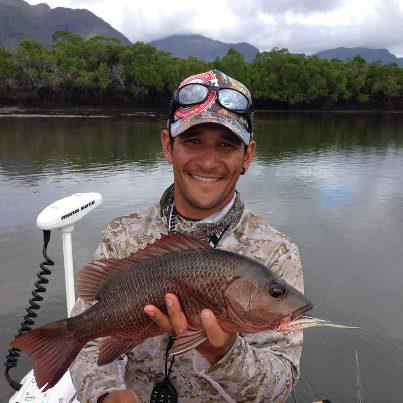
Presented by – Adam Griffiths
Fly fishing in saltwater is a very rewarding and effective way to catch many species of fish from the humble flathead to Marlin.
For a first time fly fisher it can be very daunting with different weight lines, rods, reels, and a vast array of flies and other bits that go along with it.
Fly Fishing really does not have an age limit, you can learn from a very early age or you can pick up a rod and have a go once you decide that a challenge is needed after conventional fishing for all those years.
Fly Fishing is not strickly “Land-based” you can fly fish from a large or small boat, canoe or even a kayak! You just need to be willing to explore new concepts and open your thoughts to new experiences..
We will start out by explaining some of the basics with the equipment
Line Weight
This can be anything from 1 to 15, similar to spinning or bait casting outfits that are classified by line class Eg. 4kg. Although the weight class of the rod is more related to the size and weight of fly it is used to present than the actual line class of the tippet used.
Naturally lighter weight class rods are more forgiving when fishing very light tippets due to the softness of the rod.
1 weight is obviously the lightest rod available and is designed to cast extremely small flies with a very delicate presentation.
The most common weight classes for saltwater fly fishing range from 6 to 10 weight.
And ideal starting class would be about a 7 or 8 weight.
This will enable the user to present small to medium weighted flies to a range of common and relatively easily accessible fish such as Flathead, Bream and Bass.
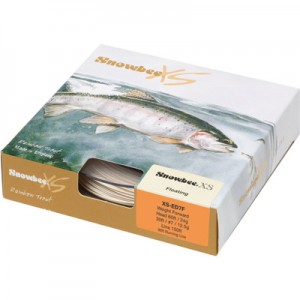 Lines
Lines
Lines come in various forms from floating to sinking and combination of both.
Your choice of line will be determined by the type of fishing and where you are fishing.
For flathead in most estuarine habitats a floating line with a sink tip is one of the most effective and easiest to manage.
For other species a full floating line may be required where you are targeting fish with popper style flies.
A floating line with a clear sinking tip will be very beneficial when targeting fish such as flathead in shallow areas where you want the fly to get down to the bottom but not drag a sinking or intermediate line across the bottom.
A full sinking line is used when fishing deeper water where you need to present the fly down in the water column Eg. Bass in Somerset dam, Snapper or Threadfin Salmon in the Brisbane River.
Lines will come in a variety of colours depending on whether you need to have a highly visible line or want it to blend into your surroundings. Eg. Bright orange for surface poppers and clear for clousers etc. when targeting flathead etc.
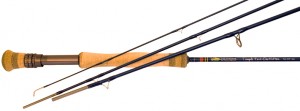 Rods
Rods
For the first time fly fisher I would recommend a seven or eight weight rod.
When selecting a rod you need to find one that feels comfortable to use for extended periods of time.
I suggest that you buy a known brand of rod such as a TFO (Temple Fork Outfitters) designed by Gary Loomis. Daiwa, Sage, Redington or Scientific Angler.
All have a good range of rods from budget to professional and most have a lifetime warranty or extended warranty programs.
As with any fishing rod purchase, buy the best quality that your budget will allow.
This will reduce the need to upgrade too soon and provide quality service for many years to come.
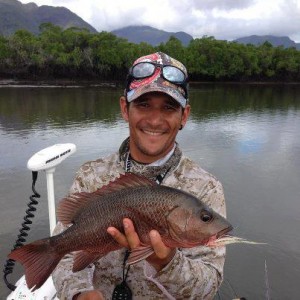 Your second rod purchase should be of a different weight rating to target either larger or smaller fish Eg. A ten weight for chasing tuna in the bay or a five weight for trout fishing etc.
Your second rod purchase should be of a different weight rating to target either larger or smaller fish Eg. A ten weight for chasing tuna in the bay or a five weight for trout fishing etc.
The range of fish that can be caught is limited only by your imagination. This “Mangrove Jack” caught by Miles Tam is an awesome testiment to what can be achieved!
Reels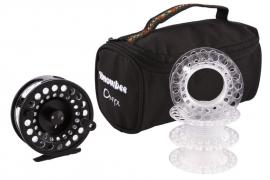
As with rods always purchase a quality reel that will give good service for many years to come.
There are some excellent reels in the market today and I would highly recommend a cassette style reel that comes with spare spools.
This gives you the versatility to be able to change from a floating to a sinking fly line without the need to purchase 2 or three separate reels.
Two very good cassette style reels are the New Era fly reels from Daiwa and the Snowbee Onyx series. Both of these come with multiple spare spools and changeover is simple and quick.
Reels are generally reversible from left to right hand with very minimal effort.
Maintenance is a simple case of a light wash in warm water followed by a wipe down with Inox on a rag
Flies
The most common flies that you will need when starting out is the old favourite the clouser.
The Clouser is a small weighted fly designed to be fished on the bottom.
They are ideal for flathead and come in a variety of colours and hook sizes.
The bass Vampire is also a weighted fly and very effective on Bass as the name would indicate as well as Flathead and Bream.
There are also several other flies that will work for these species and produce well.
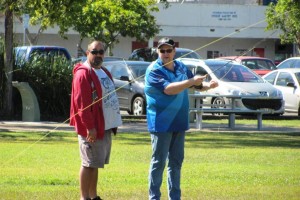 Technique
Technique
Casting a fly can be as simple or complicated as you make it, this is where you need to seek out some basic but good instruction from someone with a degree of experience in fly fishing. This can be gained from our staff here in store or from a local fly fishing club such as the Brisbane Fly fishing club who hold monthly meetings and offer casting tips as well as all other aspects of fly fishing
As with using a bait casting or spinning reels there is a degree of difficulty in casting a fly to where you need to present it in order to catch fish. Not long after this training and purchasing his first Fly Fishing outfit Peter went on to catch his first Flathead!
Starter Outfits
There are some very good starter packages available from most manufacturers such as TFO Redington, Gillies and Scientific Angler. These will come complete with rod reel line backing and in some instances a travel case to protect your purchase. This style of package can take a bit of the guess work out of setting up a good outfit for the first time fly fisher.
Packages will range in price from $125 to $400.
Other basic equipment that may be useful are:
- Stripping basket for line management when wading.
- Waders to keep yourself dry.
- Net for landing fish.
- Pliers for unhooking fish.
- Camera for photos.
You don’t need a lot of fancy extra bits and pieces aside from what you would normally take when flicking plastics or hard bodies for flathead or bream.
If you need further information or a demonstration please come in store and arrange an appointment with me.
Alternatively you can contact the Brisbane Fly Fishing Club and ask about their New Member program or go along to one of their monthly meetings where you will be more than welcome.
35 Babarra Street Australia
Stafford QLD 4053
Remember to “Keep it Basic” and Maintain the Passion!
Special Thanks
Images have been supplied by James at Tunz@Flyz, you can also check out some of his other awesome Flyz at: http://www.facebook.com/tunzaflyz
Also Adam Griffiths who has spent many years with his father Peter pursuing all manner of fish on Fly! Thank you Adam.
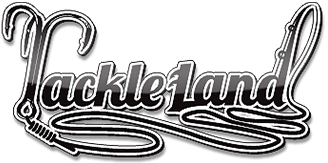
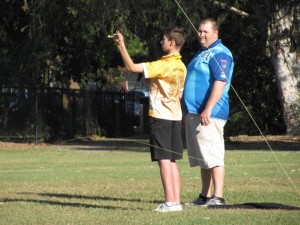
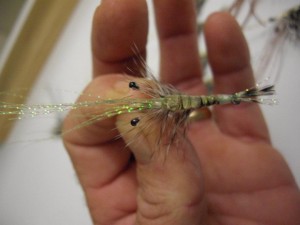
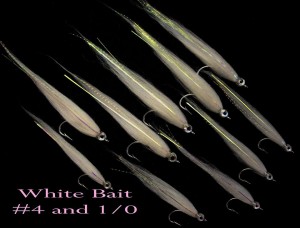
2 Comments
Do you run teaching how to cast lessons? If so what’s the damage? I’d have a toothy grin like in the photo if I got a jack that size.
Kim Monroe.
Hi Kim,
We don’t do them here but if you contact the Brisbane Fly Fishing Club, they will certainly assist you with casting tuition but the catching is up to you.. lol